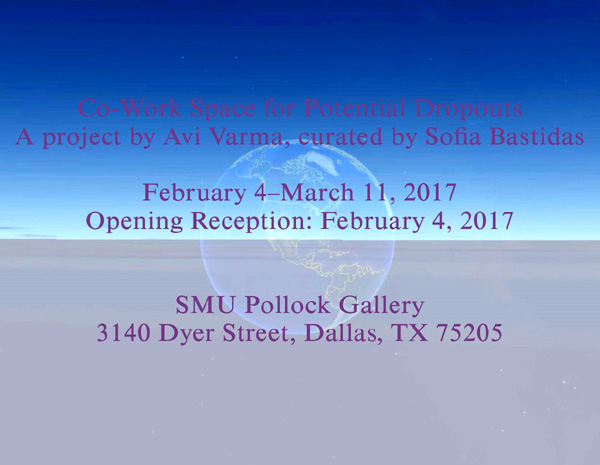SMU’s Pollock Gallery presents Co-Work Space For Potential Dropouts
The Pollock Gallery of the Division of Art at SMU’s Meadows School of the Arts will present the exhibition "Co-Work Space for Potential Dropouts" by Avi Varma, curated by Sofia Bastidas,
DALLAS (SMU) -- The Pollock Gallery of the Division of Art at SMU’s Meadows School of the Arts will present the exhibition Co-Work Space for Potential Dropouts by Avi Varma, curated by Sofia Bastidas, from February 4 through March 11, 2017.

The Co-Work Space for Potential Dropouts is an investigation into what philosopher Timothy Morton calls “ambient poetics,” incorporating physical, social and aesthetic environments in the gallery space. It addresses issues of art and politics, including advertising and global warming. The project re-creates a co-work space complete with the familiar accoutrements of a start-up company: desks, WiFi, a library and refreshments. It includes a fictional course catalogue, a website, a promotional video advertising the space, an audio loop incorporating ocean sounds and tones of sine waves, and wall signage including political slogans and quotes that inspired the exhibition. Visitors are invited to sit comfortably, relax and bask in the ocean sounds as they peruse the catalogue, which includes descriptions of 35 courses submitted by well-known artists, theorists, cultural critics, activists, curators and academics from around the world. They range from the serious to the tongue-in-cheek; examples include:
- “Conflict Shorelines,” a study of the entanglement between political conflicts and climate change, from international architects Eyal Weizman and Paulo Tavares and Princeton professor Eduardo Cadava;
- “School for Young Shamans,” inspired by faerie circles, group therapy, quilting bees and other spiritual, psychological and social forms, from artist/curator AA Bronson, founder of the Institute for Art, Religion and Social Justice at Union Theological Seminary, N.Y.; and
- “Ecologies of Excess: A pavilion for the ‘Great Exhibition of the Works of Excess of All Nations,’” set in the year 2110, from Eva Franch i Gilabert, chief curator and executive director of Storefront for Art and Architecture, N.Y.
Other topics include drone warfare, energy production, algorithmic poetry, memes, planetary art, sovereignty, corruption, think tanks and much more. Most of the course descriptions include actual reference articles and books that will be available in the exhibit’s library.
Curator Sofia Bastidas said the artists were eager to participate in the experimental project, one that is unique in the organizers’ experience. “We invited them to offer innovative ideas for students to explore – speculative courses that would move students away from the narrow, normative confines of ‘common sense’ and into a terrain of unknown futures and utopian possibility,” she said. “Most of the courses stem from real problems facing the world today, and could actually be applied in education.”
The website (which will launch soon at www.potentialdropouts.info) includes the same music used in the gallery, and an interactive version of the catalogue, which is posted with punch holes – not just in a row of three on the left side, but scattered throughout. Click on a hole, and the copy spreads around it. “We wanted people to play with it,” said Bastidas. “It’s a kind of metaphor – you can have punch holes in unexpected places and still work around them.”
On each Friday evening of the exhibit, an artist will lead interactive “Hacking the Common Sense” sessions from 5 p.m. to midnight, during which students and visitors will be able to engage in discussion and research on specific topics drawn from the fictional course descriptions.
“The Co-Work Space for Potential Dropouts expands upon movements of the avant-garde such as Kazimir Malevich’s Suprematism, the objets trouvé of Marcel Duchamp, and the ‘non-sites’ of Robert Smithson, yet inserts them into corporate, tech start-up social forms,” said Bastidas. “It has the explicit aim of expanding ideas of what is possible and commonsensical in art and politics.”
About Avi Varma:
Avi Varma (b. Dallas, 1983) received his B.A. in romantic poetry from Amherst College and his M.A. in art history and experimental film from the European Graduate School, where he studied with Judith Butler, Avital Ronnel, Slavoj Zizek, Alain Badiou and Giorgio Agamben. From 2010 to 2014 he was a disciple, in the traditional guru-shishya relationship, of musician La Monte Young and light-artist Marian Zazeela (whose Dream House was one of the original Dia Art Foundation site-specific works) at the Kirana Center for Indian Classical Music, where he studied art, composition and North Indian classical vocal music.
About the Pollock Gallery:
The Pollock Gallery is located on the first floor of the Hughes-Trigg Student Center, 3140 Dyer St. on the Southern Methodist University campus in Dallas. Gallery hours are 11 a.m. to 5 p.m. Tuesday through Saturday, with extended hours until midnight for each Friday of the Co-Work Space exhibition. The gallery is closed Sunday and Monday. Admission is free. For more information, call 214-768-4439 or visit www.smu.edu/Meadows/AreasOfStudy/Art/PollockGallery.
###